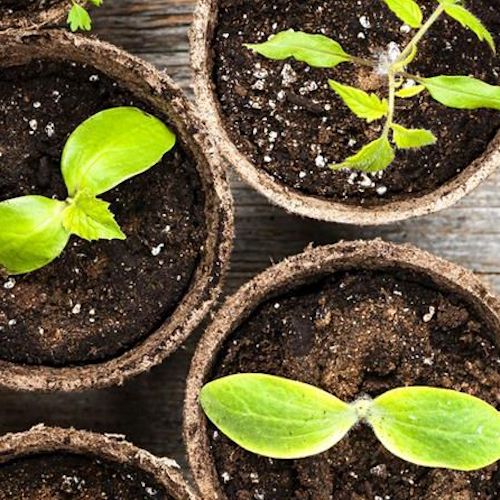If there is one variable gardeners can control, that makes a huge difference to seed-starting success, it is timing. Some seeds develop slowly but surely while others race out of the gate. Most outdoor crops - whether veggies, herbs or flowers - do best when they are grown up to about a 3" - 4" pot size timed to match the local safe planting out date. If seedlings become overgrown ahead of the planting out date they are often difficult to maintain indoors (which is stressful!) and can also be challenging to transplant without damage when the time comes. On the flip side, some selections require a long growing time to be able to flower or fruit in our short summer season, so it is important to get these going as required.
As a backdrop to the biological needs of seeds and seedlings is the cold-climate gardener's innate need to do something plant-y as winter wears on... clearly, a common reason for many gardeners sowing a little ahead of themselves. So, hopefully, our simple guide to planning your seed starting dates helps you get going with something appropriate and satisfying for each week or two as we head towards spring!
Seed starting recommendations...
|
Variety |
Timing |
Notes |
|
Annual Flowers |
March or later |
Some varieties do really well direct seeded, for example calendula and nigella |
|
Artichoke |
February thru early March |
|
|
Basil |
April or later |
Basil is very sensitive to lower winter daylight, and does so much better when started under lights or direct seeded outdoors in early June |
|
Beans |
Direct seed, early June |
Some gardeners enjoy starting beans in bio-degradable pots indoors, about two weeks before planting out date |
|
Beets |
Direct seed, early June |
|
|
Bell Peppers |
March |
Bell pepper do not need to be started as early as hot peppers |
|
Cabbage & other Brassicas |
Early May |
Direct seeding is an option for many brassicas as well, particularly leafy types |
|
Carrots |
Direct seed, late May onwards |
Carrots must be direct seeded as they do not transplant |
|
Celery |
March |
|
|
Cilantro & Dill |
Direct seed, early June |
You’ll get so much ore out of a pack of direct seeded cilantro or dill vs. starter plants! |
|
Corn |
Direct seed, early June |
Some people do start corn indoors a couple of weeks before planting out time |
|
Cucumbers |
Early May |
Start some indoors in early May, but also consider direct seeding a second crop outdoors in June |
|
Eggplant |
February or early March |
These really benefit from being started early indoors |
|
Hot Peppers |
February or early March |
These really benefit from being started early indoors |
|
Leaf Greens |
Direct seed, Mid-May onwards |
Direct seeding outdoors is best unless growing as baby greens indoors |
|
Leeks |
February or early March |
|
|
Melons |
Mid-May |
Avoid starting melons too early indoors as they become difficult to maintain in starter pots |
|
Onions |
February or early March |
These really benefit from being started early indoors |
|
Parsley |
March or later |
|
|
Peas |
Direct seed early May |
Peas are very cold tolerant and you may find success planting in thawed soil (pots) outdoors as early as April |
|
Perennial Flowers |
February or early March |
Generally, perennials will not flower their first year unless started early indoors and also develop more slowly compared to most annuals |
|
Perennial Herbs |
Early March |
Oregano, thyme, sage, lemon balm etc |
|
Poppies |
Direct seed early May |
These really require outdoor sowing during cool, early spring weather |
|
Pumpkins and Squash |
Early May |
Avoid starting pumpkins and squash too early indoors as they become difficult to maintain in starter pots |
|
Radish |
Direct seed early May |
Direct seeding is the only way to go… and is very easy! |
|
Shallots |
February or early March |
These really benefit from being started early indoors |
|
Sunflowers |
Mid-May, or direct seeded in early June |
Large type sunflowers are best direct seeded, while dwarf types can be started indoors or direct seeded |
|
Sweet Peas |
Mid-April, or direct seeded in early May |
Sweet peas seeds are direct seeded while temperatures are cool, in early spring |
|
Tomatillo / Ground Cherry |
Early April |
These can be started a little later than tomatoes |
|
Tomato |
Late March to Mid-April |
Starting any earlier than the third week of March often leads to overgrown, floppy plants that are a challenge to care for |
|
Wildflowers |
February or early March |
Generally, perennials will not flower their first year unless started early indoors and also develop more slowly compared to most annuals; fall is another ideal time to sow these |







